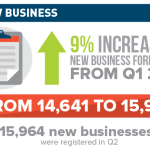
According to the U.S. Small Business Administration, small businesses make up 99.7% of U.S. employer firms. As of 2010, there were over 27.9 million small businesses in the United States. Small businesses have a lot of power to impact their local economy and enact real change in their communities and the world. Every large business in existence started out as a small business. Small business owners should know that the choices they make for their company can significantly impact people’s lives.
One major challenge facing job seekers and employers alike is the skills gap. This gap is what happens when educated potential employees leave school without necessary skills for the workforce. The skills gap means that employers have difficulty finding qualified applicants, even though the number of applicants is high. Employers can do a lot at their company and in their field to help eliminate the skills gap and give people the skills needed to benefit our economy.
Job Descriptions
When creating job descriptions for open positions, employers should consider the actual required skills for the position, and how much working knowledge needs to be in existence. For example, proficiency in certain software programs may be useful, but the ability to learn new programs may be even more useful. So instead of requiring vast experience in a specific program, require experience in a certain *type* of program or proof of ability to learn a program. If a position requires daily use of certain functions, chances are that anyone hired on with the relevant learning skills will pick it up fairly quickly.
Be sure that job descriptions don’t eliminate people simply to save a couple hours of training. And if you’re requiring a certain amount of education or experience, make sure your salary offer matches your requirements. If you want to pay less, be willing to put the resources into training someone. If you don’t want to train someone, don’t expect to be able to pay an entry level wage.
Training
 Training may seem like a post-skills-gap issue, but companies can work with local schools and community programs to give community members the skills needed to be successful in entry-level positions. This can involve outreach and internships with local high schools and community colleges, community programs that introduce interested potential employees to basic job functions, and community tours that introduce the public to what your company does.
Training may seem like a post-skills-gap issue, but companies can work with local schools and community programs to give community members the skills needed to be successful in entry-level positions. This can involve outreach and internships with local high schools and community colleges, community programs that introduce interested potential employees to basic job functions, and community tours that introduce the public to what your company does.
The more familiar potential applicants are with your company and basic job functions, the higher the probability that the community can fulfill your employment needs. By investing in your community, you’re making it easier for your company to find local applicants and avoid having to relocate employees from afar.
Once employees are hired, make sure you offer sufficient training for each employee to learn the basic functions of their job. Once this is met, look into ways to up-train employees for opportunities for internal advancement. This will show that you’re interested in helping employees move up. It will also offer them skills to be more efficient in their current positions. The more capable your employees are, the fewer employees you’ll have to hire. As your employees advance in skill level, their efficiency will increase and your company will benefit.
Employee Appreciation
The biggest way to prevent the skills gap from affecting your company is to keep the employees you already have. Up-training is one way to accomplish this. The other major strategy is to keep employees happy by showing them that they are valued. In some businesses, this might be providing valued team members with improved office space or equipment. If offices aren’t functional for your business model, make sure that team members still have a space they can personalize and keep their things, like desks, cubbies, or metal lockers.
In addition to offering a healthy work environment, you want to make sure your wages and benefits packages remain competitive within your industry and account for all the experience and value your employees bring to your company. Even if you can’t offer extra benefits like life insurance packages, your HR department can help educate employees on personal finance issues. This can be as easy as providing existing resources like educational documents on commonly misunderstood life insurance terms, or lists of local professionals that can assist your employees in life planning. Acknowledging and valuing your employees’ lives outside of work will motivate your employees to give their best during work hours.
These are just some ways that small businesses can help address the skills gap, both in their own company and in their larger community. Do you have more ideas? Share in the comments!















